London Plane Tree: Leaves, Bark, Flowers (Pictures) – Identification Guide
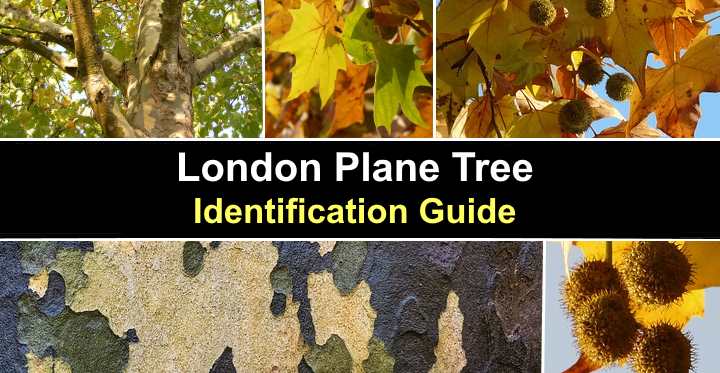
A London plane tree (Platanus x acerifolia) is a species of deciduous tree native to Europe and Asia. The London plane tree is identified by its distinctive shape, with a broad trunk topped by a large crown of branches. The London plane has dark green leaves like maple leaves, consisting of several pointed lobes. The flowers appear in spring, followed by small green spiky fruits, which ripen into dense clusters of seeds.
A London plane tree is one of the most popular trees in the United Kingdom. However, the hybrid tree grows well in urban environments. It is found in major cities across the United States as a popular street tree. The urban tree is also useful for planting in large metropolitan areas as it helps to filter out pollutants from the air.
This article is a complete guide to identifying the London plane tree (also written planetree). Descriptions and pictures of this sycamore-like tree will help to identify it in an urban landscape. In addition, you will find out about growing this hardy plane tree in your garden if you need a majestic shade tree.
Facts About London Planetree (Platanus × acerifolia)

London Plane tree (Platanus × acerifolia)
The London plane tree is a hybrid deciduous tree of the American sycamore (Platanus occidentalis) and Oriental plane tree (Platanus orientalis) species. The large tree grows between 66 and 100 ft. (20 – 30 m) tall with a large, rounded crown up to 75 ft. (22 m) wide.
The London plane tree used to have the botanical name Platanus x hispanica. This is because hybridization is thought to have happened in Spain. The new scientific term for the tree refers to the maple (acer) shape of its leaves. Therefore, it’s sometimes called the maple-leaved plane tree.
The London planetree looks like a regular sycamore tree. The palmately lobed leaves look like sycamore or maple leaves, and small drooping clusters of round flowers bloom in spring. However, common sycamore trees are rarely planted in dense urban environments.
Planetrees have a distinctive pyramidal shape that gradually develops into an oval silhouette as the tree matures. The tree’s dense leafy foliage, spreading canopy, and height make it an ideal shade tree if you have space in your front or backyard.
Several features of a London plane tree’s growth make it ideal for urban conditions. First, the London planetree is relatively fast-growing, and it grows about 1 to 2 ft. (0.3 – 0.6 m) per year. Second, the tree’s rapid growth means that it will be a sizable tree within a few years.
London planetrees also have a long lifespan. It is thought that the Platanus acerifolia can live for hundreds of years, even in an urban setting. The tree’s longevity may be down to how it sheds its grayish-brown bark, removing pollutants and parasites that accumulate on the outer bark.
London Plane Tree Leaves

London plane tree leaves
Leaves on a London plane tree are identified as attractive light to dark green leaves with three to five pointed lobes. Visually, a planetree leaf looks like a maple leaf or sycamore tree leaf. The large, pointed leaves with toothed margins measure 7” (17 cm) long and up to 10” (25 cm) wide.
There are a few additional ways to identify a London plane tree by its leaves. First, the leaf base is typically straight. Also, the toothed leaf margins along the lobes give the leaves a jagged appearance. Finally, in the fall, the deciduous leaves turn a spectacular orange-yellow to copper-brown.
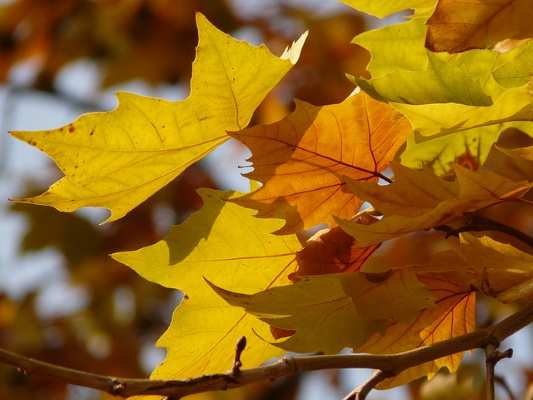
London plane autumn foliage
London Plane Tree Bark
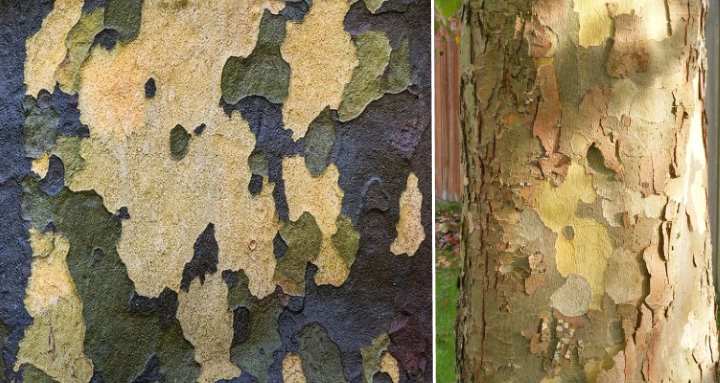
London plane tree bark
The bark on a London plane tree makes it easily recognizable in a landscape. The bark on a London plane tree has a distinctive gray mottled appearance that develops when it exfoliates, revealing white, brown, and creamy yellow colors. This distinctive camouflage pattern makes it easy to identify a London plane tree from a distance.
The bark of the planetree sheds because of the tree’s rapid growth. The thin bark doesn’t expand as quickly as the tree, and large flakes of bark drop off every year. However, this characteristic growth pattern promotes the tree’s health. When shedding the brownish-gray bark, the tree gets rid of pests, harmful parasites, and pollutants.
London Plane Tree Flowers
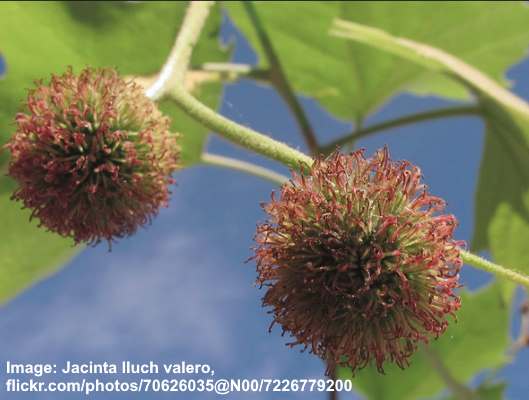
London plane tree female flowers
Flowers growing on a London plane tree bloom in early spring. The ball-shaped catkins of tiny red or greenish-yellow flowers form pendulous balls dangling in clusters of two or three. Each spherical flower head measures around 1” (2.5 cm) in diameter. The catkins measure 1.6” – 3.2” (4 – 8 cm) long.
A London plane tree is classified as a monoecious tree—meaning that male and female flowers grow on the same tree. Female planetree flowers are bright red fuzzy balls and the male flowers are a greenish-yellow color.
London Plane Tree Fruit
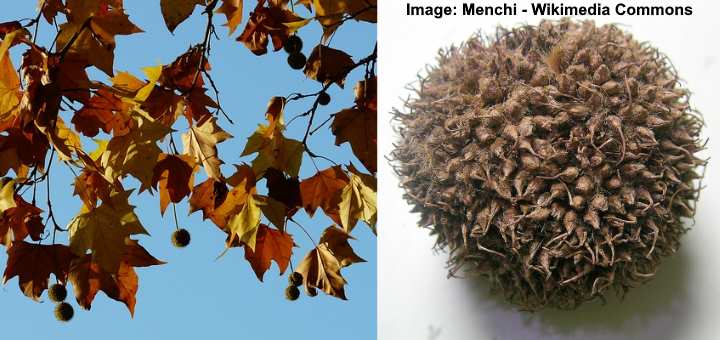
London plane tree fruit
Fruit from a London plane tree is brown seed balls dangling in clusters from fall, throughout the winter until spring. The spiky fruits on a planetree form a dense cluster of seeds (achenes) with a fuzzy appearance that stays on branches in winter. Seed dispersal is by the wind that carries the downy tufts long distances.
London Plane Tree Identification
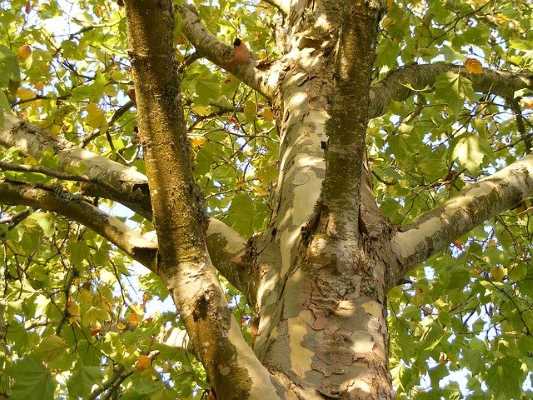
London plane tree can be identified by its distinctive bark and leaf shape
The easiest way to identify a London plane tree is to look at the bark and leaf shape. The planetree has a distinctive mottled bark with a gray, white, yellow, and brown camouflage-style pattern. Large maple-like leaves with pointed margins are the other identifying feature of a London plane tree.
London Planetree vs. Sycamore
You can tell the difference between a London plane tree and a sycamore tree is by looking at the bark, leaves, and flowers.
Mottling on the London plane tree bark starts at the base of the trunk. However, sycamore bark only peels away higher on the tree, closer to the crown. And the exfoliated bark of planetrees reveals yellow inner bark, not whitish bark like a sycamore tree.
London plane tree leaves have more pronounced jagged lobes than a sycamore tree. Comparing pictures of sycamore leaves and planetree leaves shows the center lobe of London plane trees is more extended than wide. In comparison, the central lobe on a sycamore leaf is somewhat stumpy.
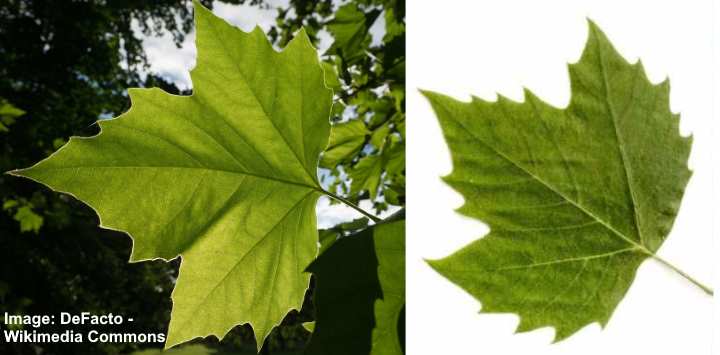
London plane leaf (left) vs. sycamore leaf (right)
Lastly, flowers on London plane trees grow in clusters of two and three, rarely one. However, sycamore ball-like flowers and spiky fruits don’t grow in groups. Instead, they always produce individual fruits growing solitary.
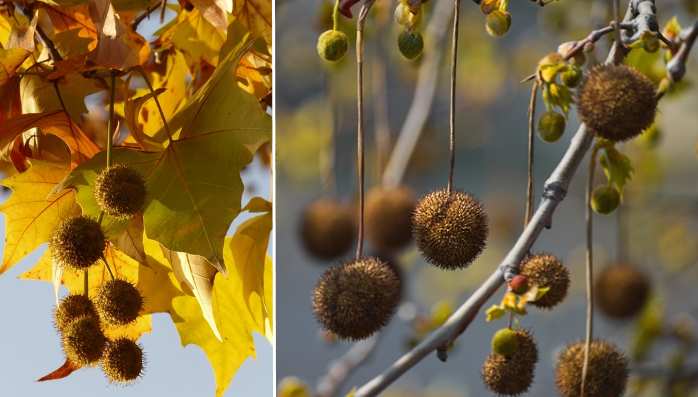
London plane seed head (left) vs. sycamore seed head (right)
Further reading: Sycamore Trees – Identification Guide.
London Plane Tree Cultivars
Several London plane cultivars have been developed to be more disease-resistant and hardy in urban conditions. Also, some planetree cultivars have attractive variegated foliage.
Here are some popular varieties of London plane trees.
Platanus x acerifolia ‘Bloodgood’ — This planetree variety is resistant to anthracnose fungal diseases. The tree grows 60 ft. (18 m) tall and is tolerant of drought, poor soils, and urban pollution.
Platanus x acerifolia ‘Columbia’ — The attractive feature of this London plane tree variety is its dark green, deeply lobed leaves. This variety also has excellent anthracnose resistance.
Platanus x acerifolia ‘Liberty’ — A fast-growing, vigorous planetree with a pyramidal crown that tolerates mildew, drought, and heat exceptionally well.
Platanus x acerifolia ‘Suttneri’ — A beautiful variety of Lonon plane tree with variegated maple-like leaves that feature creamy-white variegation.
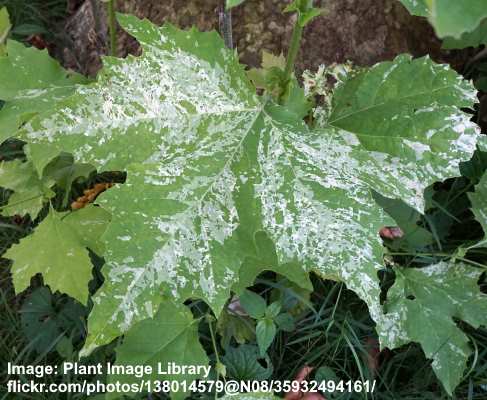
Variegated leaf of ‘Suttneri’ London plane
Platanus x acerifolia ‘Alphen’s Globe’ — This dwarf London plane tree has green leaves that turn yellow in the fall. This planetree is ideal if you have a compact garden as it only grows 13 to 16 ft. (4 – 5 m) tall.
How to Plant London Plane Tree
When deciding on planting a London plane tree, you should choose a location with full sun or partial shade. Additionally, you will need to ensure enough space for the broad canopy that reaches up to 70 ft. (21 m) wide. This means it should be at least 30 ft. (10 m) away from buildings.
To plant a London plane tree, dig a hole as deep as the root ball and twice as wide. Place the tree in the hole, then backfill the hole with soil amended with compost. After that, water the tree daily until the roots begin to grow. Once the planetree becomes established, water it enough to keep the ground moist but not soggy.
How to Grow London Plane Tree
To grow a London plane tree, ensure the tree has plenty of sunlight and consistently moist soil. During hot sunny periods, water it more often. Only apply fertilizer if it is growing in poor, nutrient-deficient soils. Prune in winter to maintain its shape and height.
If you are looking for a fast-growing tree with beautiful foliage, then a London plane tree is ideal. It grows quickly and is an excellent shade tree.
Where to Grow London Plane Tree
A London plane tree performs best in full sun, getting at least six hours of sunlight daily. The hardy tree tolerates some partial shade; however, its typically rapid growth will slow down if it gets fewer than four hours of light. Additionally, too much shade may lead to powdery mildew.
A London plane tree adapts well to various types of soils. But it grows best in humus-rich, deep soil that has excellent draining. You can also grow a London plane tree in sandy, loamy, clay, or compacted soil. Additionally, it performs in soils of varying pH levels—it doesn’t matter if the soil is alkaline or acidic.
London plane trees thrive in most environments in USDA zones 5 through 9. The planetree will withstand hot summers and survive harsh winters.
How to Water London Plane Tree
Although tolerant of some drought, a London plane tree has medium to high water needs. Ideally, the ground should never completely dry out. So, you will have to water the planetree regularly, especially during hot weather. Adding mulch around the root area can help keep the soil moist.
When watering a London plane tree, always ensure you deeply water the entire root area. However, you should avoid watering too close to the trunk as this can encourage disease. Instead, thoroughly saturate the root area and beyond the canopy line.
Deep watering twice a month should be enough to keep your London plane tree thriving in most conditions. The ground should be wet to a depth of 18” to 24” (45 – 60 cm).
Fertilizing London Plane Tree
A London plane tree benefits from fertilizing twice a year—in early spring and fall. Apply a balanced tree fertilizer to boost the nutrient content of the soil. You should follow the instructions, taking into account the soil quality and size of the tree.
Because London plane trees adapt to various soil conditions, fertilization isn’t always necessary. However, noticing severe leaf drop could indicate that the tree needs more ‘feeding.’ In this case, it’s good to test the soil to know the correct type of fertilizer to use.
How to Prune London Plane Tree
Regular pruning of a London plane tree helps to maintain its height and develop an attractive shape. Of course, cutting back a planetree is necessary to remove dead, decaying, or diseased branches. Typically, pruning is done in late fall or early winter.
Pruning using the pollarding method is a popular way to prevent London plane trees from becoming too large. Pollarding cuts stems back to almost the main trunk to develop short, stumpy branches. To achieve this result, cut back branches at the end of the season by pruning just above old growth.
It’s good to note that London plane trees recover well from pruning regardless of the time of year.
How to Propagate London Plane Tree
Taking stem cuttings is the most effective way to propagate a London plane tree. Take a few 10” (25 cm) hardwoods cuttings of the current season’s growth just after the leaves drop. Look for growth eyes or leaf buds on the stem. Then strip some of the bark from the cut end.
To root the London plane tree cuttings, place them in a suitable pot filled with moist, well-draining potting soil. You can then plant the cuttings directly in the ground where you want the tree to grow. The cuttings should root by the arrival of spring.
It is possible to propagate London plane trees by seed. However, seed germination is not always successful, and it will take longer to grow a large planetree.
Pests Affecting London Plane Tree Growth
Common pests affecting London plane trees include sycamore lace bugs, aphids, Japanese beetles, and scale insects. These annoying bugs and insects may cause damage to leaves, but they will rarely affect the tree’s health.
Here are some ways to identify pest problems on London plane trees:
Sycamore lace bugs (Corythucha ciliata): These small white sap-sucking insects feed on the underside of planetree leaves. The effects of these pests include bleached leaves or foliage with stippled patterning.
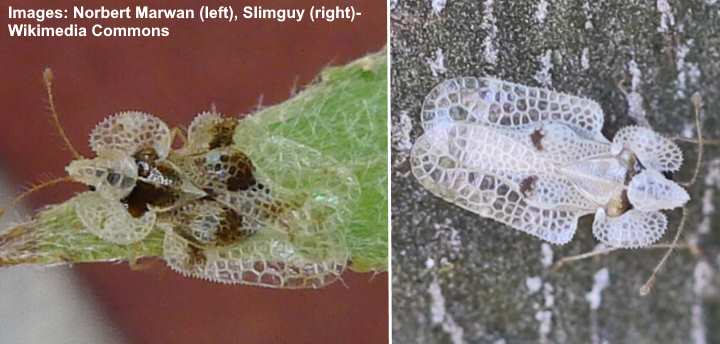
Sycamore lace bugs (Corythucha ciliata)
Japanese beetles (Popillia japonica): These iridescent green and brown beetles feed on leaves and skeletonize leaves, giving them a lacelike appearance. If there is a severe Japanese beetle problem, the tree may look like it’s been scorched by fire.
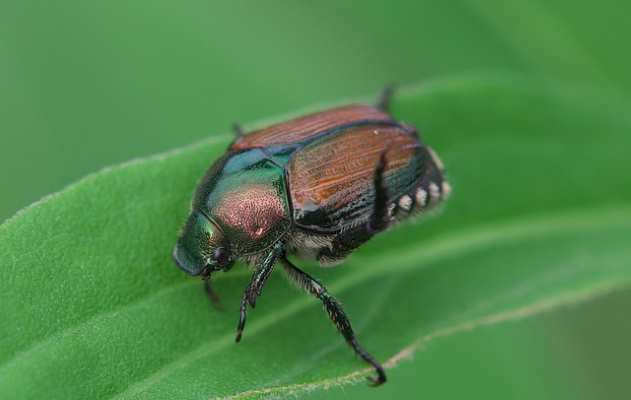
Japanese beetle
Related reading: How to get rid of Japanese beetles.
Sycamore scale insects (Stomacoccus platani): These destructive pests can cause the most damage to Platanus trees. Infested leaves look distorted and brown spots appear. Then, the leaves gradually turn brown and die.
Related reading: How to kill scale insects on plants.
Of course, common garden pests such as caterpillars, aphids, mites, and whiteflies can also affect the foliage. If you have a severe problem with aphids, you may notice many ants around the London plane tree.
Diseases Affecting London Plane Tree Growth

Sycamore anthracnose is a common fungal disease that affects London plane trees. Left picture: leaf anthracnose. Right: Leaves falling due to severe infection of Sycamore anthracnose
A common fungal disease affecting London plane trees is sycamore anthracnose. The condition can cause leaf spot, and brown blotches will appear on leaves. If the infection is severe, leaves may drop prematurely in spring. Brown leaf spots can also cause mature leaves to fall.
Unfortunately, repeated attacks of anthracnose can significantly weaken the tree leaving it susceptible to other diseases and pest infestations.
The best way to avoid sycamore anthracnose is to ensure you water the tree adequately. For example, you should only irrigate the ground area where the roots extend and avoid splashing water on leaves. Additionally, over-fertilization can cause anthracnose to develop.
Another way to avoid fungal tree foliage diseases is to prune infected branches to increase air circulation. Cool, damp conditions can lead to various issues with leaf disease.
Alternatively, you can plant varieties of London plane trees that are resistant to anthracnose.
Related articles:
